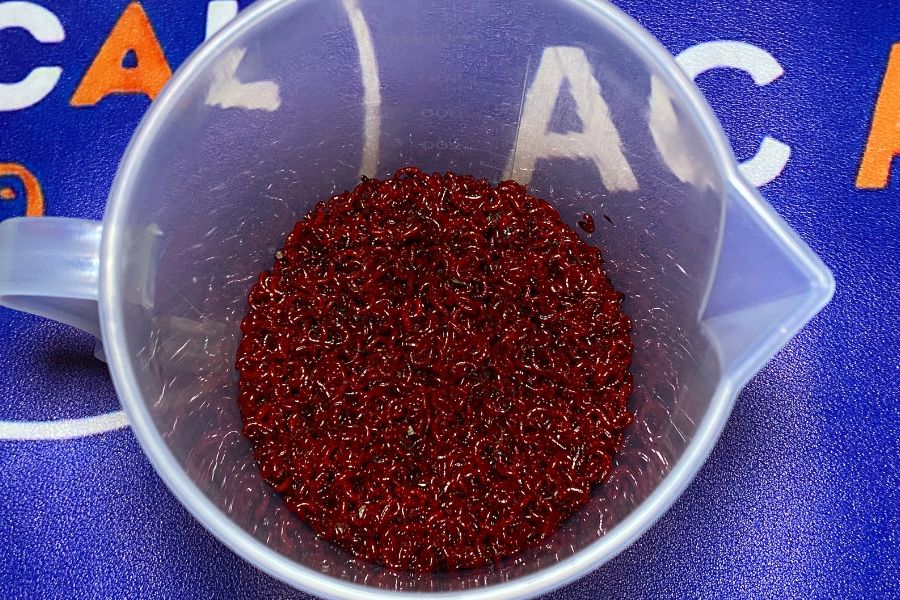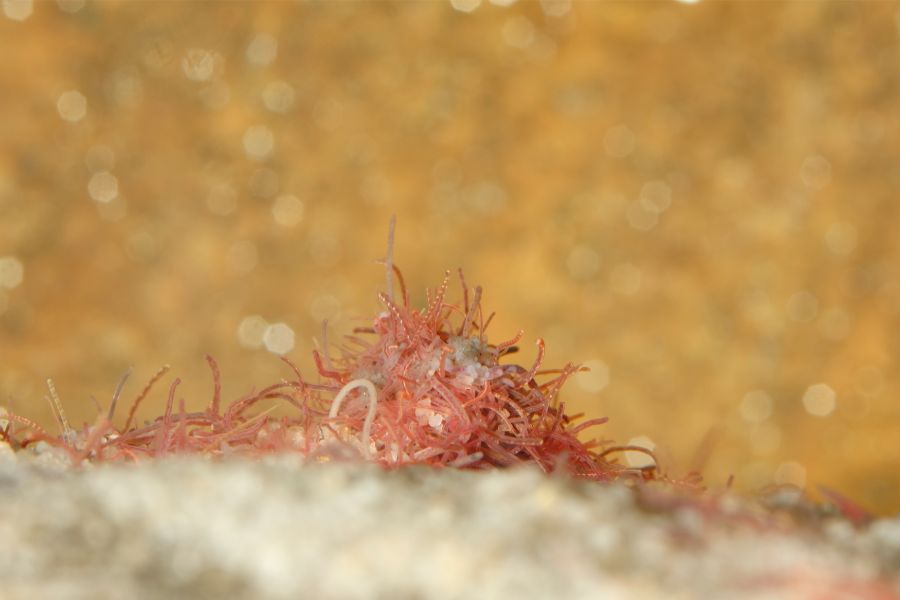Bloodworms are among the most popular “fish treats” around, and even the most newbie aquarists can buy them in frozen or freeze-dried form.
That said, there’s so much more to this yummy fish treat. Understanding what bloodworms are, their nutritional benefits, and how to breed them will bring much value to your aquatic pets. It can be tricky to learn everything about them, but luckily, that’s why we’re here.
In this article, we’ll delve deep into this fish superfood and tell you everything you need to get the most value out of it!
What are Blood Worms?
Bloodworms are small invertebrates that are often used as a food source for fish in the aquarium.
There’s some confusion about what bloodworms are, exactly, since the term is used in a variety of ways in the aquarium trade. To make it simpler, let’s differentiate their two uses.
- Color: Many stores and aquarists can refer to a worm as a “bloodworm” due to its coloration. They get their name from their red coloration, not because they suck blood from their prey. Tubifex worms, for instance, are technically not the same species as “true” bloodworms, but they can be referred to as such because of their color.
- Type: There are true bloodworms out there, the ones that actually need to suck blood in order to survive. Some are parasitic worms, while others are insect larvae.
In the next section, we’ll discuss three of the most common worms that aquarists pertain to when they’re talking about bloodworms: Tubifex, Glycera, and Chironomidae.
Tubifex
Tubifex worms are the most common “bloodworms” you can find for your tropical aquarium fish, like Bettas. They belong to the Tubificidae family but are often called “sludge worms” since they’re often found in polluted waters.
They get the nickname “bloodworms” from the high hemoglobin content in their blood, giving them their rich, red color.
Tubifex worms can usually be bought as freeze-dried treats – easy to store and can be kept at room temperature for long periods without going bad. They’re pretty high in fat and protein content, so they’re a great nutrition source for any fish that love bloodworms.
However, due to their high fat content, you should only give them in moderation as it’s extremely possible to give your fish digestion issues when you overfeed them with this.
Additionally, be careful where you get them from, particularly if you’re getting them alive. Tubifex are especially known to carry diseases, so make sure you buy them from a reputable dealer that can guarantee the worms are disease-free.
Chironomidae
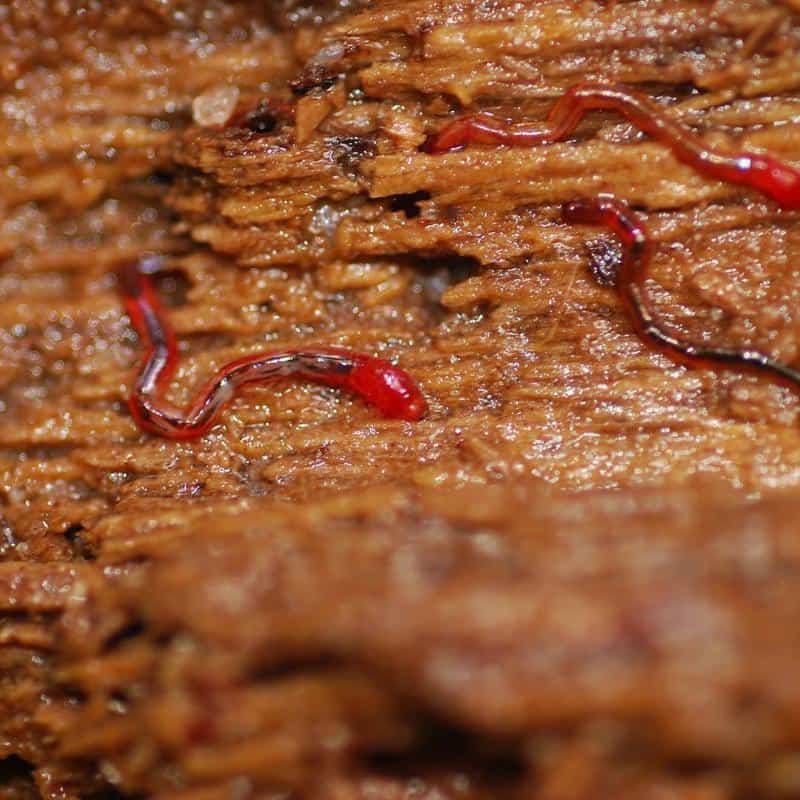
Chironomidae bloodworms are the larvae form of non-biting flies. They typically live in shallow waters, and they’re important parts of freshwater ecosystems because of their nutritional value.
They’re some of the most popular live feed for freshwater aquarium fish and amphibians. They also tend to move around a lot, giving fish much entertainment while they eat.
They’re very high in protein content, so they can be great fish treats if they’re given in moderation.
Glycera
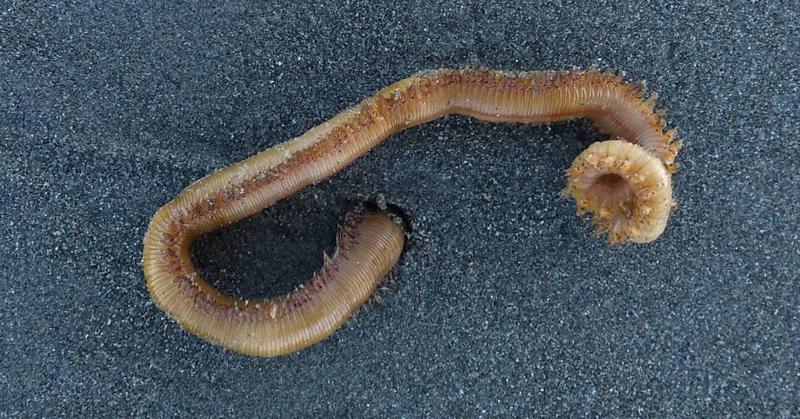
Glycera worms, also known as proboscis worms, are segmented worms found in brackish and marine habitats but are also sold in the aquarium trade as food for fish.
Unlike Tubifex worms, these ones don’t come freeze-dried; you can usually find them alive at stores that sell fish bait. They’re true bloodworms and can be quite terrifying, as they can literally suck blood from fish and other aquatic animals. Worse, they can grow as long as
Because of this, they’re not as popular in the freshwater aquarium trade, especially beginners. They’re mostly popular in the marine aquarium trade, where the fish can be much larger and hardier, as well as fishkeepers who like catching their own fish.
Types of Bloodworms as Fish Food
Bloodworms are typically sold in different forms, and each one has its own pros and cons.
Live
Live bloodworms are bloodworms in their most natural forms. They’re a highly sought-after treat for various ornamental fish since they wriggle around and give fish more entertainment while eating.
Pros
- High nutritional value. Live bloodworms are packed with proteins, essential amino acids, and fats. Best of all, they get to retain these since they’re untouched by the typical preservation techniques.
- Natural hunting simulation. The wriggling motion of live bloodworms triggers a natural hunting response in fish, providing mental stimulation. It can be a great enrichment for your fish every once in a while.
- Readily accepted by most fish. Most species readily recognize live bloodworms as food, so you can rest assured that practically all freshwater aquarium fish will find them appealing.
Cons
- Storage and handling. Keeping live bloodworms requires specific storage conditions and careful handling to maintain their freshness. They can easily die and foul up if these requirements are unmet, which means you’ll need additional effort and equipment to keep them for a long time.
- Risk of disease. Live bloodworms can introduce diseases to the aquarium if not sourced from reputable suppliers. You’ll need to double-check where they’re coming from to make sure.
- Short shelf life. They have a limited shelf life, which means you’ll need to frequently purchase them if you want to make them a constant treat for your fish.
Freeze Dried
Freeze-dried bloodworms are live bloodworms that have been freeze-dried to remove moisture, preserving their nutritional value and making them last longer.
You’ll need to speak freeze-dried bloodworms in aquarium water before offering them to your fish.
Still, are freeze-dried bloodworms good for fish? The short answer is yes, but there are some disadvantages, as well.
Pros
- Nutrient retention. Freeze-drying preserves most of the nutritional content, providing a similar nutrient profile to live bloodworms without all the hassle.
- Convenient storage and handling. They are easy to store and handle, eliminating the need for live worm maintenance.
- Long shelf life. Freeze-dried bloodworms have a longer shelf life than live ones, so you don’t have to keep buying live bloodworms whenever you need to feed your fish.
Cons
- Rehydration is required. Before feeding, freeze-dried bloodworms must be rehydrated, which can alter their texture and take longer.
- Texture and feeding differences. Some fish may be picky about the texture of freeze-dried bloodworms compared to live ones. Plus, there also won’t be any mental stimulation that live bloodworms provide.
- Easier to overfeed your fish. Due to their lightweight nature, it’s easy to overfeed fish with freeze-dried bloodworms because you do not give your pets enough.
Frozen
Frozen bloodworms are live bloodworms that have been flash-frozen to retain their nutritional content and preserve their natural form.
When using frozen bloodworms, always make sure that you thaw them properly before putting them inside the aquarium.
Pros
- Nutrient-rich. Freezing locks in the natural nutritional value of live bloodworms, unlike freeze-drying, which strips away some nutritional content.
- Easy storage. Frozen bloodworms are easy to store, and their resealable packaging allows for easier portion control.
- Minimal processing. They undergo minimal processing, ensuring a more natural diet for your fish.
Cons
- Thawing required. Before feeding, frozen bloodworms need to be thawed in a separate container using aquarium water, which can be inconvenient, especially if you have a lot of tanks.
- Texture differences. Frozen worms, especially when frozen for some time, will not have the same texture as live ones. Some fish may not as readily take these.
- Limited shelf life. Once thawed, frozen bloodworms should be used within hours, or they will foul.
Fresh Gel
Fresh gel bloodworms are preserved in a gel-like substance to maintain their natural appearance and nutritional value, negating the change of texture that happens when freezing or freeze drying.
That said, not all fish like them, and understandably so. They’re the least natural of all these bloodworm forms. If you’re giving your fish fresh gel bloodworms for the first time, make sure you observe your fish and see if they like it.
Pros
- Fresh gel bloodworms are pre-packaged and ready to use when you want to feed your fish, eliminating the need for thawing or culturing.
- Added nutrients and minerals. The gel preserves the nutritional content of bloodworms, providing essential nutrients for your fish. Plus, the gel will often have added minerals such as beta-carotene, which is great for your fish.
- No-mess preparation. The gel reduces mess compared to live or frozen bloodworms that must be handled or thawed, making feeding more convenient and hygienic.
Cons
- Texture differences. Some fish may prefer the texture of live or frozen worms over the gel-encased ones, so be sure to buy smaller packets and try them out in your aquarium first.
- Packaging issues. Packaging quality can vary depending on the brand, affecting the freshness of the gel bloodworms. Be careful of feeding your fish bad bloodworms, which can negatively impact their health and even alter water parameters.
Benefits of Bloodworm Food for Your Fish
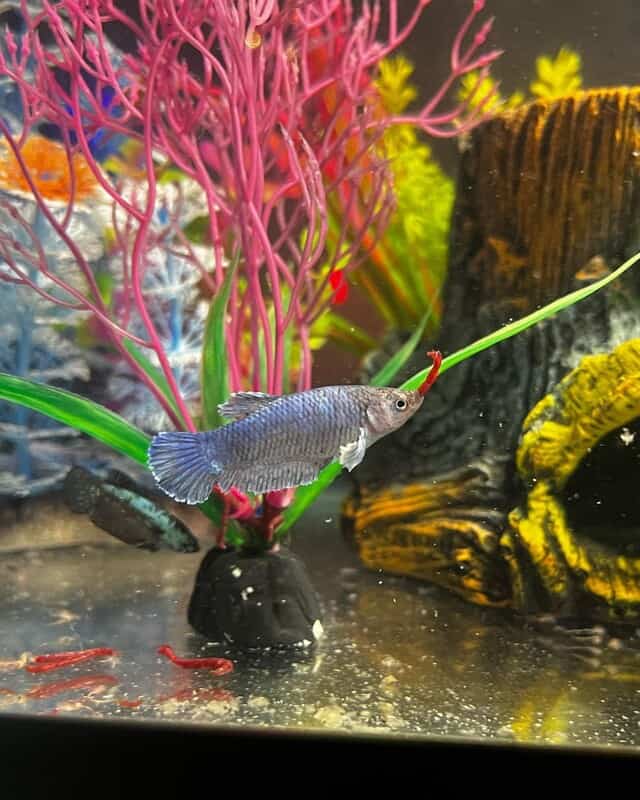
We’ve talked about what bloodworms are and the different types of this food you can find in the market – but why exactly should you feed your fishes these fish food?
In this section, we’re going to talk about all the benefits that bloodworms have for your aquarium.
Nutritional Value
Bloodworms are a powerhouse of nutrition for your aquatic companions, which makes them great food.
Packed with protein, essential amino acids, and vitamins like B12 and E, they support healthy growth, vibrant coloration, and stronger immune systems in your fish. This protein-rich nutritional profile ensures your fish receive the vital elements they need to thrive.
Availability
Bloodworms offer a readily available and natural food source. Freeze-dried and frozen options are commonly found in pet stores, making it extremely convenient to provide your fish with this nutrient-rich treat.
Bloodworms come in different forms, such as cubes or loose, offering various feeding methods that cater to different tank setups and fish preferences.
Plus, you can even source them from the wild if you need to. Bloodworms are natural parts of nature, so you can find them easily if you know where to look. You’ll need to be cautious and wary when feeding wild-caught bloodworms to your aquarium.
Ease of Cultivation
For more adventurous and knowledgeable hobbyists, cultivating your own live bloodworms can be a practical and rewarding activity to bolster your fish’s diet.
Setting up a small-scale blood worm culture can provide your fish a constant and fresh food source. It does require constant attention, though, especially at first, but successfully breeding your bloodworms can lead to a sustainable, cost-effective, and enriching food option.
Disadvantages of Bloodworm Food for Your Fish
While bloodworms are great for your pets, it’s not the holy grail of fish food. There are some disadvantages to consider, especially if you plan to feed bloodworms regularly to your aquatic friends.
Need for Live Culture
Blood worm larvae are perishable and have a limited shelf life, so if you want to incorporate fresh bloodworms into your tank’s regular diet, you’ll need your own culture.
Culturing bloodworms can be time-consuming and requires proper conditions such as temperature, water quality, and feeding. Relying solely on a live culture can be challenging for beginners or those with limited space.
High Fatty Content
Bloodworms are naturally rich in fats, which can be both an advantage and a drawback.
While some fish benefit from the energy these fats provide, excessive consumption can lead to health issues such as gastrointestinal problems, obesity, and even fatty liver disease.
Overfeeding with bloodworms can disrupt the nutritional balance of your fish’s diet, affecting their overall well-being.
Fishes Becoming “Hooked”
Bloodworms are highly palatable to many fish species, and some fish can become reliant on them as their primary food source.
This can lead to a reluctance to consume other types of food, causing nutritional deficiencies and limiting their diet variety. Encourage your fish to accept a diverse diet; preventing dependence on bloodworms alone is crucial.
Popular Fish That Eat Bloodworms
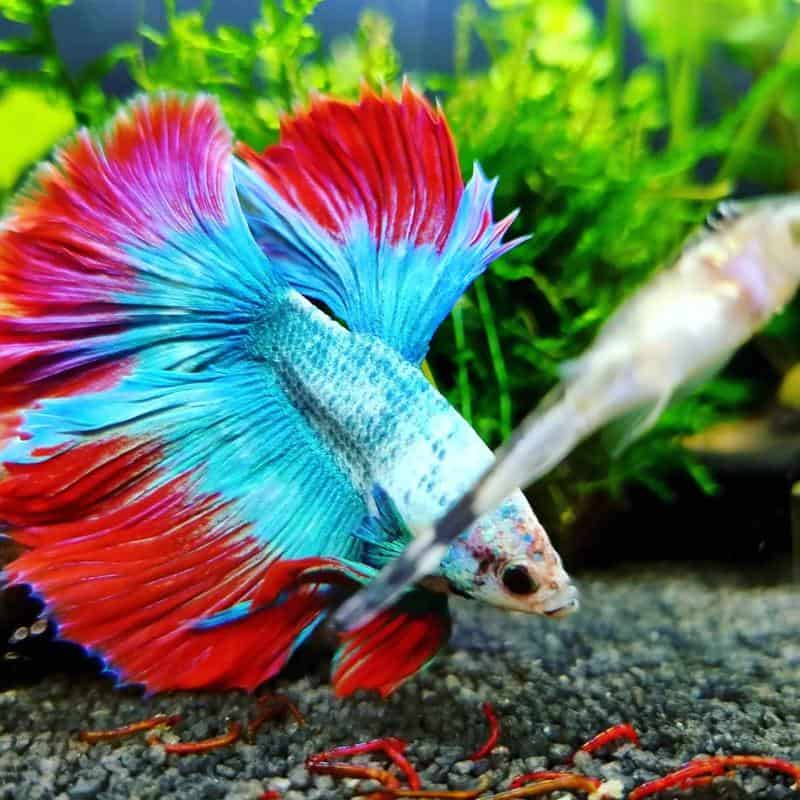
Now that you know what bloodworms are and the pros and cons of their various types, you should answer the question: what fish can eat bloodworms?
You might be surprised to note that while most fish will eat bloodworms, some species are more suited for regular feeding of it than others.
Bloodworms are an excellent supplement for carnivorous and omnivorous fish that thrive on protein-rich diets. These fish can efficiently utilize not just the nutrients but also the high fatty content of bloodworms.
Some notable examples include the following.
- Axolotl
- Betta fish
- Gouramis
- Cichlids
- Tetras
- Livebearers
Now, you might ask the question: do shrimp eat bloodworms? The answer to that would be yes. Most shrimps are omnivores and would gladly hunt and eat bloodworms.
Other invertebrates that enjoy bloodworms are turtles, crayfish, crabs, and even snails.
Cultivating Blood Worms at Home
Cultivating bloodworms at home can be a rewarding way to provide fresh and nutritious food for your aquarium fish. Here’s a simplified five-step process to get you started:
- Get a fully covered container with transparent walls or cover that will let the sun in and not let anything get inside.
- Your bloodworms need soil (any kind of soil) to thrive, so put about 3-6 inches of soil into the lid.
- Now your bloodworms have a home – but what do bloodworms eat? For that, mix cow or chicken manure into the habitat in your soil, as this is what your worms will eat for nutrition.
- Mix water (any kind, as long as it’s not chlorinated) into your soil to make a thick paste.
- Acquire midge fly eggs from the wild or egg dealers, and put them into your habitat.
- Cover your mud and fly egg mixture with dead leaves and detritus. Ensure it gets plenty of sunlight.
- Wait for 5 to 10 days for your blood worm to mature. At this point, cover your habitat completely and do not let anything in.
- After ten days, your blood worm will then hatch.
- You can continue feeding your bloodworms with manure once they hatch.
- Bloodworms mature into midge flies 10 to 30 days after hatching, so harvest them before them.
Keep in mind that cultivating bloodworms requires patience and attention to the quality of their habitat. Strict maintenance and proper feeding are essential for a successful blood worm culture.
FAQs
Are Bloodworms Good for Fish?
Bloodworms are rich in nutrients, protein, and fats, making them a nutritious supplement for many aquarium fish. However, be careful of overfeeding your fish.
Where Do Bloodworms Come From?
Bloodworms are the larvae of midges, small flies that belong to the Chironomidae family. They hatch in moist or submerged, nutrient-rich ground.
Where Do Bloodworms Live?
Bloodworms naturally inhabit aquatic environments such as ponds, lakes, and slow-moving streams. However, you can culture them in enclosed habitats with soil and water.
Are Bloodworms Harmful to Humans?
No, bloodworms are not harmful to humans. They are commonly used as fish food and pose no health risks when handled properly.
What Are Bloodworms Used For?
Bloodworms are a natural food source for aquarium fish due to their high nutritional value. They provide a protein-rich diet for many species, and live ones provide valuable enrichment and stimulation for fishes and invertebrates alike.
Final Thoughts
Bloodworms for fish are often a good idea – but like everything else, there are a lot of hidden complexities that will only be uncovered once you dig deeper.
Bloodworms are an excellent source of nutrients and protein, but you need to carefully balance them with other forms of food, as they can pose some health and social risks if regularly used for overfeeding.
But if you’ve read this far, you know everything you need to know about what bloodworms are and how to properly incorporate them into your fish’s regular diet!
